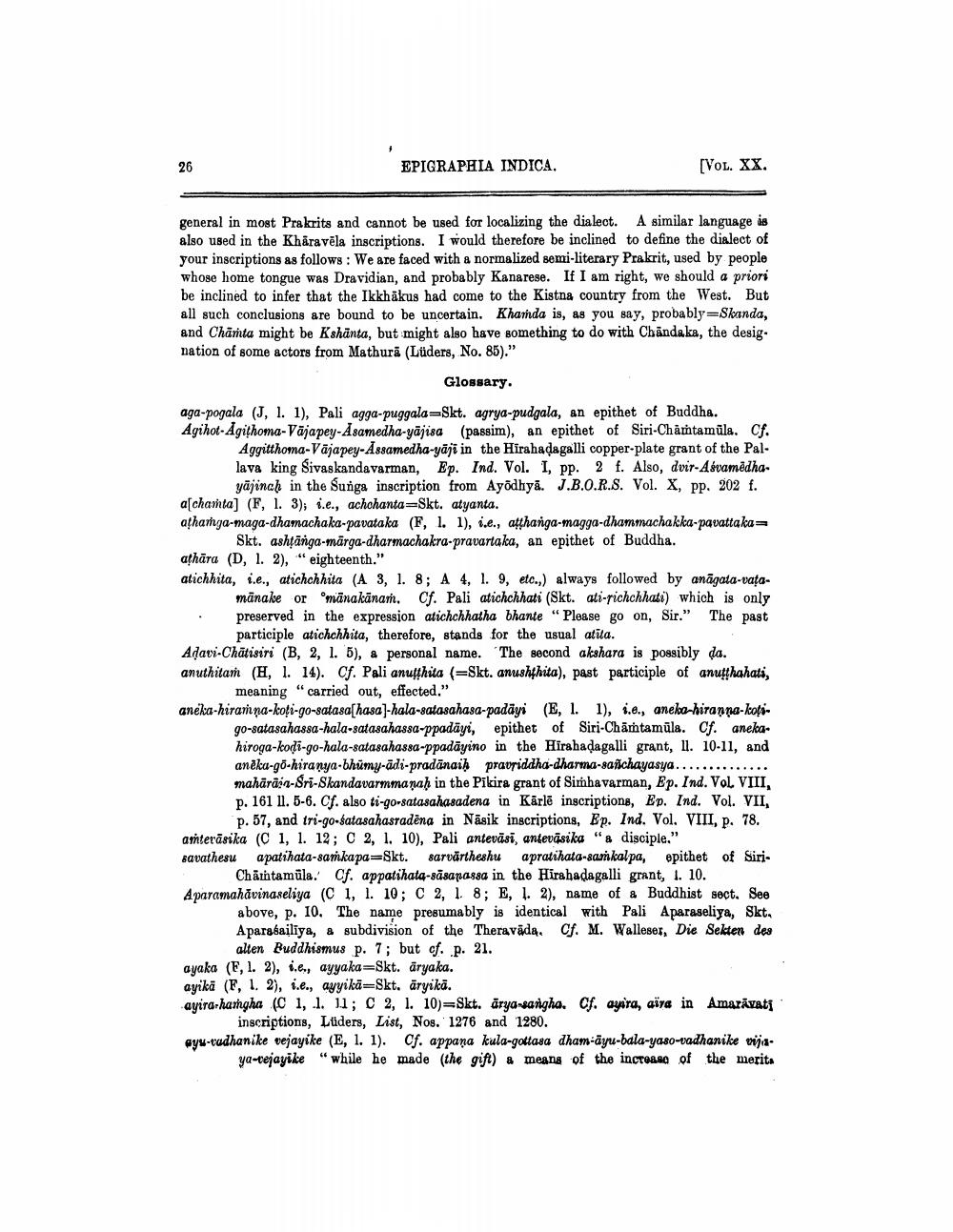________________
26
EPIGRAPHIA INDICA.
[VOL. XX.
general in most Prakrits and cannot be used for localizing the dialect. A similar language is also used in the Kharavela inscriptions. I would therefore be inclined to define the dialect of your inscriptions as follows: We are faced with a normalized semi-literary Prakrit, used by people whose home tongue was Dravidian, and probably Kanarese. If I am right, we should a priori be inclined to infer that the Ikkhākus had come to the Kistna country from the West. But all such conclusions are bound to be uncertain. Khamda is, as you say, probably Skanda, and Chamta might be Kshanta, but might also have something to do with Chandaka, the designation of some actors from Mathura (Lüders, No. 85)."
Glossary.
aga-pogala (J, 1. 1), Pali agga-puggala-Skt. agrya-pudgala, an epithet of Buddha. Agihot-Agithoma-Vajapey-Asamedha-yajisa (passim), an epithet of Siri-Chamtamula. Cf.
Aggitthoma-Vajapey-Assamedha-yaji in the Hirahaḍagalli copper-plate grant of the Pallava king Sivaskandavarman, Ep. Ind. Vol. I, pp. 2 f. Also, dvir-Asvamedha. yajinah in the Sunga inscription from Ayodhya. J.B.O.R.S. Vol. X, pp. 202 f. a[chamta] (F, 1. 3); i.e., achchanta Skt. atyanta. athamga-maga-dhamachaka-pavataka (F, 1. 1), i.e., atthanga-magga-dhammachakka-pavattaka= Skt. ashtanga-marga-dharmachakra-pravartaka, an epithet of Buddha. aṭhāra (D, 1. 2), "eighteenth."
atichhita, i.e., atichchhita (A 3, 1. 8; A 4, 1. 9, etc.,) always followed by anagata-vața
manake or manakanaṁ. Cf. Pali atichchhati (Skt. ati-richchhati) which is only preserved in the expression atichchhatha bhante "Please go on, Sir." The past participle atichchhita, therefore, stands for the usual atita.
Adavi-Chatisiri (B, 2, 1. 5), a personal name. The second akshara is possibly da. anuthitam (H, 1. 14). Cf. Pali anutthita (=Skt. anushthita), past participle of anutthahati,
meaning "carried out, effected."
go-satasahassa-hala-satasahassa-ppadayi,
aneka-hiramna-koti-go-satasa hasa]-hala-satasahasa-padayi (E, 1. 1), i.e., aneka-hiranna-kotsepithet of Siri-Chamtamula. Cf. anekahiroga-kodi-go-hala-satasahassa-ppadayino in the Hirahaḍagalli grant, 11. 10-11, and aneka-go-hiranya-bhumy-adi-pradānaiḥ pravriddha-dharma-sañchayasya.... mahārain-Sri-Skandavarmmanaḥ in the Pikira grant of Simhavarman, Ep. Ind. Vol. VIII, p. 161 11. 5-6. Cf. also ti-go-satasahasadena in Karle inscriptions, Ep. Ind. Vol. VII, p. 57, and tri-go-satasahasradena in Nasik inscriptions, Ep. Ind. Vol. VIII, p. 78. aṁterāsika (C 1, 1. 12; C 2, 1. 10), Pali antevāsi, antevāsika "a disciple." savathesu
apatihata-samkapa-Skt. sarvartheshu apratihata-sankalpa, epithet of SiriChaintamula. Cf. appatihata-sasanassa in the Hirahadagalli grant, 1. 10. Aparamahāvinaseliya (C 1, 1. 10; C 2, 1. 8; E, 1. 2), name of a Buddhist sect. See
above, p. 10. The name presumably is identical with Pali Aparaseliya, Skt. Aparasailiya, a subdivision of the Theravada. Cf. M. Walleser, Die Sekten des alten Buddhismus p. 7; but cf. p. 21.
ayaka (F, 1. 2), i.e., ayyaka Skt. āryaka.
ayika (F, 1. 2), i.e., ayyika-Skt. äryikā.
ayira hamgha (C 1, 1. 11; C 2, 1. 10) Skt. arya-sangha. Cf. ayira, aira in Amaravati inscriptions, Lüders, List, Nos. 1276 and 1280.
ayu-vadhanike vejayike (E, 1. 1). Cf. appana kula-gottasa dham-ayu-bala-yaso-vadhanike vijaya-vejayike "while he made (the gift) a means of the increase of the merits




